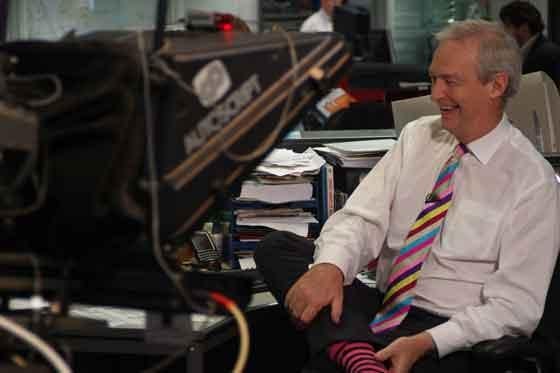
Presented by Jon Snow, Channel 4 News enjoys an iconic status in British journalism. It is the defining public service programme of the channel, which this week celebrates its 25th anniversary.
An hour-long news programme, twice the length of rivals was part of the original brief for Channel 4, laid down by Jeremy Isaacs, but realising the ambition was far from easy in its first two years.
It was such a disaster that it regularly racked up zero ratings, the first editor was removed after eight months and the maker, ITN, warned the show was on probation and could be cut.
Channel 4 News only started to come together in the summer of 1984, when it covered the miners strike with energy and originality, culminating in a live debate in August between Ian MacGregor for the National Coal Board and miners’ leader Arthur Scargill.
This long struggle to create the current durable format was possible because Channel 4 at birth had a protected status, the programme budget was provided by the ITV companies, which meant it was insulated from the financial consequences of mistakes.
The channel’s founders had definite views, a vision really, about the sort of news they wanted. Analysis and issues were watchwords.
They aimed at serious people and thought that if more than one million watched it would probably be the wrong sort of programme. (In the event they were correct about their selective appeal – audiences have remained remarkably constant at roughly that figure).
They wanted no frivolity, no royal stories, no sport, car crashes or routine crime. They would concentrate on the important things: the economy, world politics, American elections, energy, business, science, the arts. This was news by exclusion. Like muesli without sugar it would need careful mixing.
The first chairman of Channel 4, Edmund Dell, a former Labour secretary of state for trade and industry, added pressure: he wanted news with the authority of the Financial Times, and a dash of The Economist.
It was expected by the regulator, the Independent Broadcasting Authority, that ITN would supply this demanding programme.
But the problem was that neither Isaacs nor Liz Forgan, his head of news and current affairs, were sure ITN could make something sufficiently different from News at Ten. To them ITN represented tabloid news. They were royalty mad. When Lady Diana Spencer had exposed a nipple walking upstairs at the Royal Opera House the ITN team zoomed in and circled it.
So there was a contest of sorts, with LWT’s director of programmes John Birt and associate Barry Cox putting forward a proposal for a daily dose of news analysis, rejected when Channel 4 reluctantly agreed ITN was its best hope.
Forgan, who now chairs the Scott Trust, was a newspaper journalist, recruited by Isaacs from The Guardian. He regarded it as perfect that she knew nothing about the techniques of television because he wanted fresh perspectives.
But this was a handicap. ‘However clever we were, we were amateurs at television news,’Forgan later reflected.
To reinforce this bid to be different, Channel 4 insisted on an editor without television baggage, an experiment never repeated. They chose Derrik Mercer, managing editor of The Sunday Times. They also recruited journalists from newspapers, rather than television. Hardly anyone had experience of making extended news features, rather than snappy 90-second reports.
Forgan firmly rejected the offer of ITN’s supreme newscaster, Sir Alastair Burnet, as presenter of Channel 4 News, though he was a former editor of The Economist, because he was too identified with ITV.
Sir Trevor McDonald, a key correspondent on the early Channel 4 News described watching the opening night’s item – on the American midterm elections – this way: ‘I have seen the new age of television, in which case it is the end of mine.”
He later (politely) walked out of a Channel 4 drinks party when a commissioner said to him that the programme should let people speak in their native tongues on air, rather than voicing them over in English.
Peter Sissons, who survived to become its first main anchor, said the first six months were the worst of his professional life.
By 2 November, 1983, a year after the channel had gone on air, a new expert editor, Stewart Purvis, relaunched the programme and started to lick it into shape.
He did this partly by analysing a news report every night after the programme, to give the journalists a template to copy.
His key insight was that analysis could be interjected within the story telling. It didn’t have to be earnest, grave and usually grey-haired talking heads. Forgan was persuaded.
But he also won the backing of Sir Richard Attenborough, the channel’s deputy chairman who told him: ‘Darling, we are all, you know, in show business. Never forget that will you?”
With the format fixed, the programme settled down, though from time to time Forgan would ring up to berate Purvis for running the wrong sort of stories. There was an internal row, for example, about whether the Hungerford massacre was a news story.
In 1989 Peter Sissons was recruited by the BBC to chair Question Time, after Sir Robin Day retired. Michael Grade, then chief executive, decided that Jon Snow would replace him, and he was taught how to use an auto cue and conduct interviews by the next editor, Richard Tait.
Snow injected energy and exhibited a refusal to be caged within the studio. He became so closely identified with the programme, that no-one else has ever been considered.
At times, the iconic status has worked against Channel 4 News, notably in 1996/97, when privatisation loomed. Grade instructed ITN not to change a jot, the chattering classes liked it just as it was.
It was kept in aspic, and briefly over-shadowed by Five News presented by Kirsty Young.
The next chief executive Michael Jackson called for a competitive tender in 1997, and Mentorn, which made Question Time, put in a serious bid. ITN won through, but the process
led to the removal of the then Channel 4 news editor Sara Nathan and the appointment of the current one, Jim Gray.
At this point, the entire news agenda was smartened up, the set redesigned, and Jon Snow started wearing trendy ties.
The news was extended first to Saturdays then to Sundays and then to midday.
A review in 2005 improved its internet presence, established a foreign bureau in China, and recruited new correspondents, but its agenda remained unchanged.
Throughout its history, it has been seen within the channel as being on too early for people in the South East. Now, with Channel 4+1, the new time-shifted version of the channel, Channel 4 News at 8 pm is more accessible for opinion formers.
But longevity and a fixed point are strengths. ITV is scrambling to bring back News at Ten. The BBC is struggling to integrate rolling News 24 with discrete news bulletins.
In other words, after a difficult birth, Channel 4 News seems untouchable.
Maggie Brown is a media writer. Her book, A Licence to be Different: The Story of Channel 4, is published by BFI on 8 November, price £16. Available from www.bfi.uk/filmstore
Email pged@pressgazette.co.uk to point out mistakes, provide story tips or send in a letter for publication on our "Letters Page" blog




